Discover how different yoga styles can enhance your flexibility, build strength, and integrate mindfulness into your practice. Hatha yoga offers foundational postures for strength and flexibility. Vinyasa promotes dynamic movement and breath synchronization. Yin targets deep tissues for flexibility and mindfulness. Explore how these styles can cater to your unique needs and elevate your overall well-being.
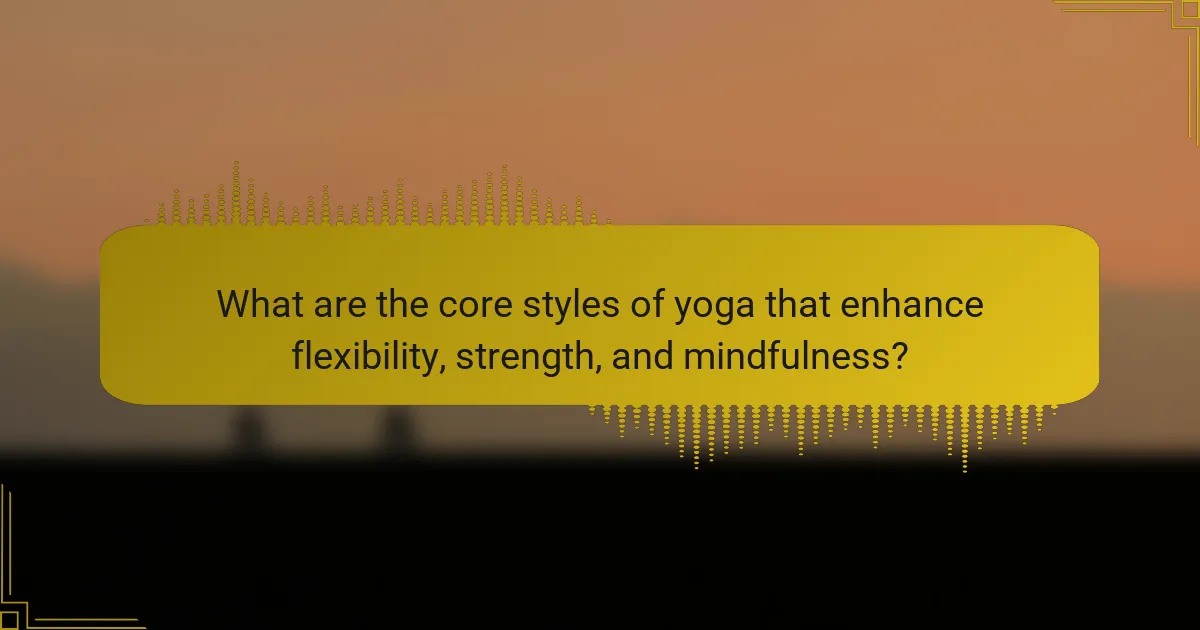
What are the core styles of yoga that enhance flexibility, strength, and mindfulness?
Hatha, Vinyasa, and Yin yoga are core styles that enhance flexibility, strength, and mindfulness. Hatha yoga focuses on foundational postures, improving flexibility and strength. Vinyasa yoga emphasizes fluid transitions, building strength and promoting mindfulness through breath synchronization. Yin yoga targets deep connective tissues, enhancing flexibility and fostering mindfulness through long-held poses. Each style offers unique benefits, catering to various needs and preferences in yoga practice.
How does Hatha yoga contribute to flexibility and strength?
Hatha yoga significantly enhances flexibility and strength through a combination of postures and breath control. The practice involves a variety of asanas that stretch and strengthen muscles, promoting overall physical balance.
Regular Hatha yoga sessions increase muscle elasticity, which contributes to improved flexibility over time. As participants hold poses, they engage different muscle groups, building strength and endurance.
Additionally, the mindful breathing techniques integrated into Hatha yoga help to deepen stretches, allowing practitioners to achieve a greater range of motion. This unique attribute of combining breath with movement differentiates Hatha yoga from other styles.
As a result, practitioners often experience increased mobility and strength, making Hatha yoga an effective choice for those seeking to enhance their physical capabilities.
What role does Vinyasa play in building strength and mindfulness?
Vinyasa plays a crucial role in building strength and mindfulness through its dynamic flow of postures. This style emphasizes transitions between poses, enhancing muscular endurance and coordination. As practitioners synchronize breath with movement, they cultivate present-moment awareness, fostering mindfulness. Vinyasa’s unique attribute is its adaptability, allowing for various intensity levels to suit individual fitness goals. Regular practice can lead to improved physical strength and mental clarity, making it a valuable approach in yoga for holistic well-being.
How does Ashtanga yoga facilitate flexibility and mental focus?
Ashtanga yoga enhances flexibility and mental focus through its structured sequences and breath synchronization. The practice involves progressive postures that gradually increase in difficulty, promoting physical adaptability. Each pose requires concentration, fostering mindfulness and mental clarity. This dual focus on body and mind creates a holistic approach to wellness. Regular practice can lead to improved range of motion and enhanced cognitive function.
What are the unique benefits of Yin yoga for flexibility and relaxation?
Yin yoga uniquely enhances flexibility and relaxation through long-held poses that target deep connective tissues. This style promotes increased circulation, reduces stress, and fosters mindfulness. Additionally, Yin yoga encourages the release of tension, allowing for greater mobility and a calm mind. Its focus on breath and stillness cultivates a profound sense of inner peace.
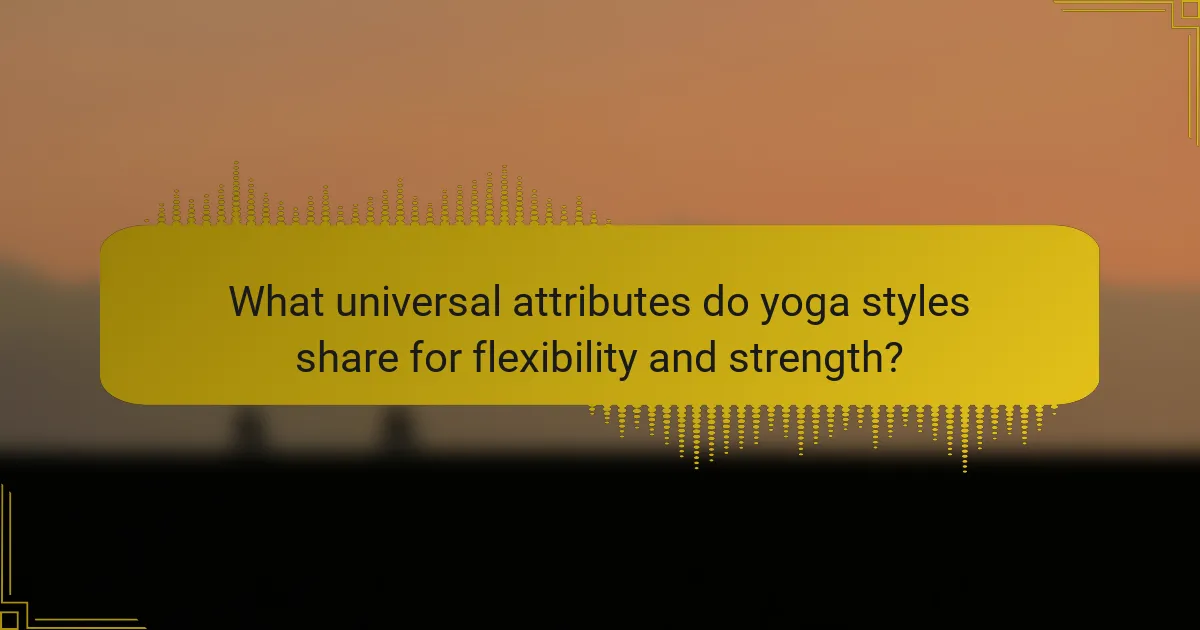
What universal attributes do yoga styles share for flexibility and strength?
Yoga styles universally promote flexibility and strength through consistent practice and targeted postures. These styles emphasize dynamic movements, breath control, and alignment, fostering both physical and mental resilience. Common attributes include increased muscle strength, enhanced range of motion, and improved balance. Each style, whether Hatha, Vinyasa, or Ashtanga, uniquely contributes to these outcomes while integrating mindfulness principles. The rare attribute of individualized practice allows practitioners to tailor their approach, maximizing benefits based on personal needs and goals.
How do breath control techniques enhance physical performance?
Breath control techniques significantly enhance physical performance by improving oxygen efficiency and focus. They enable practitioners to maintain stamina during intense activities. For example, pranayama in yoga optimizes lung capacity, leading to better endurance. Additionally, these techniques reduce stress, allowing for improved mental clarity and concentration, which are essential for peak performance.
What is the significance of posture alignment across different yoga styles?
Posture alignment is crucial across different yoga styles as it enhances flexibility, strength, and mindfulness. Proper alignment maximizes the benefits of each pose, reducing injury risk and improving overall practice efficacy. For instance, in Hatha yoga, alignment focuses on physical stability, while Vinyasa emphasizes fluid movement with breath, both requiring precise posture for optimal results. Additionally, alignment fosters mindfulness by encouraging practitioners to connect with their bodies and breath, deepening their awareness.
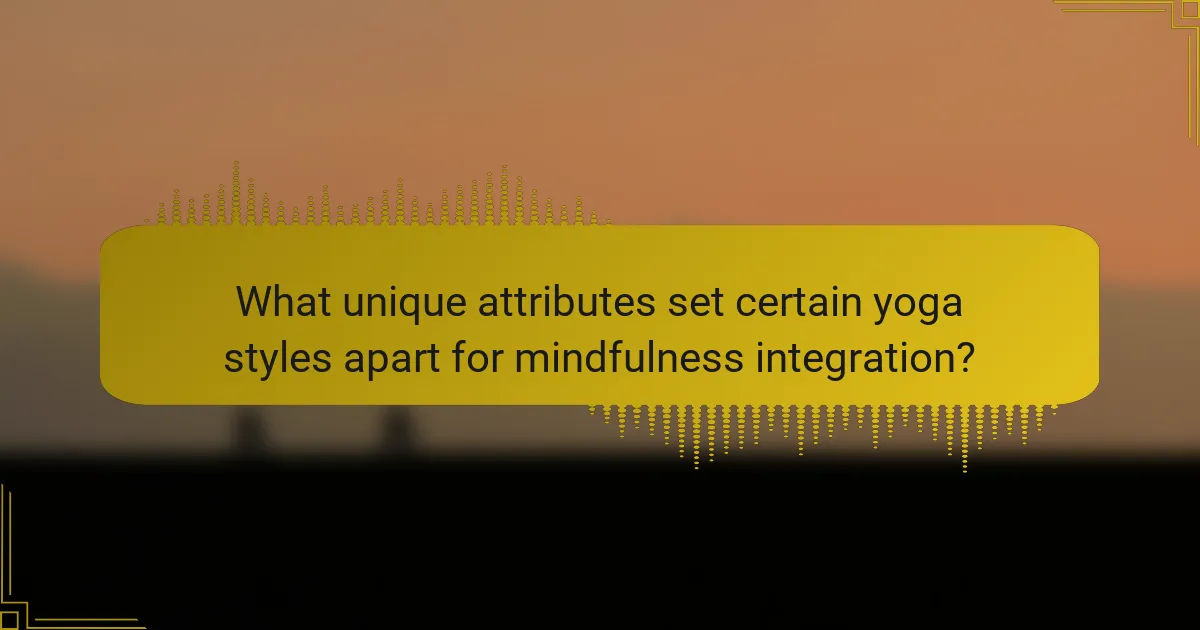
What unique attributes set certain yoga styles apart for mindfulness integration?
Certain yoga styles uniquely enhance mindfulness through their specific practices and philosophies. For instance, Hatha yoga emphasizes slow movements and deep breathing, fostering present-moment awareness. Vinyasa yoga integrates breath with dynamic sequences, promoting flow and focus. Yin yoga, characterized by long-held postures, encourages introspection and mental stillness. Kundalini yoga combines movement, breath, and sound to awaken consciousness, enhancing self-awareness. Each style’s distinct approach cultivates mindfulness in different ways, appealing to various preferences and needs.
How does Kundalini yoga uniquely promote mindfulness and awareness?
Kundalini yoga uniquely promotes mindfulness and awareness through its dynamic practices and meditative techniques. This style emphasizes breath control, movement, and sound to awaken the Kundalini energy, enhancing mental clarity and emotional balance. The incorporation of chanting and meditation fosters a deep connection to the self, facilitating present-moment awareness. Additionally, the focus on specific postures and breathing patterns encourages practitioners to cultivate a heightened sense of body awareness, leading to improved mindfulness in daily life.
What differentiates Restorative yoga in its approach to mindfulness?
Restorative yoga uniquely emphasizes deep relaxation and mindfulness through passive stretches and prolonged postures. This approach fosters a heightened awareness of the body and breath, allowing practitioners to cultivate inner peace. Unlike other styles, restorative yoga utilizes props to support the body, enabling a meditative state that encourages introspection. This gentle practice enhances flexibility and strength while integrating mindfulness into each session.
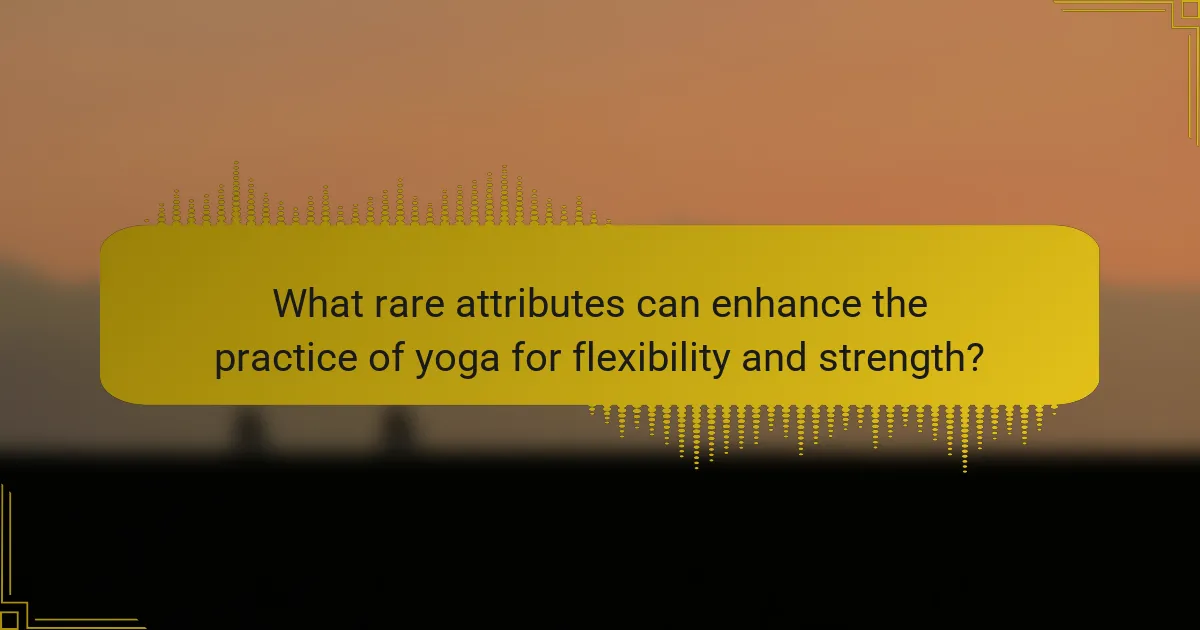
What rare attributes can enhance the practice of yoga for flexibility and strength?
Rare attributes that can enhance yoga practice for flexibility and strength include the integration of unique breathing techniques, the use of props for deeper stretches, and the incorporation of specific mindfulness practices. These elements can significantly improve muscle engagement and body awareness. For instance, utilizing a wall during poses can enhance alignment and support, while advanced pranayama techniques can deepen the mind-body connection. Such rare attributes foster a more holistic approach to yoga, optimizing both physical and mental benefits.
What are the benefits of incorporating props in yoga for improved flexibility?
Incorporating props in yoga enhances flexibility by providing support and alignment. Props like blocks and straps help deepen stretches, allowing for a safer practice. They enable practitioners to maintain proper form, reducing the risk of injury. Additionally, props can assist in achieving poses that may be challenging, promoting gradual improvement in flexibility. This supportive approach fosters a more mindful practice, encouraging body awareness and relaxation.
How can specific breathing techniques like Pranayama enhance strength training in yoga?
Specific breathing techniques like Pranayama can significantly enhance strength training in yoga by improving oxygen flow and mental focus. Pranayama regulates breath, which increases endurance and stamina during physical exertion. Enhanced lung capacity allows practitioners to maintain strength poses longer and with better form. Additionally, the meditative aspect of Pranayama fosters mindfulness, leading to improved body awareness and alignment. This integration not only boosts physical performance but also promotes mental resilience, essential for overcoming challenges in strength training.
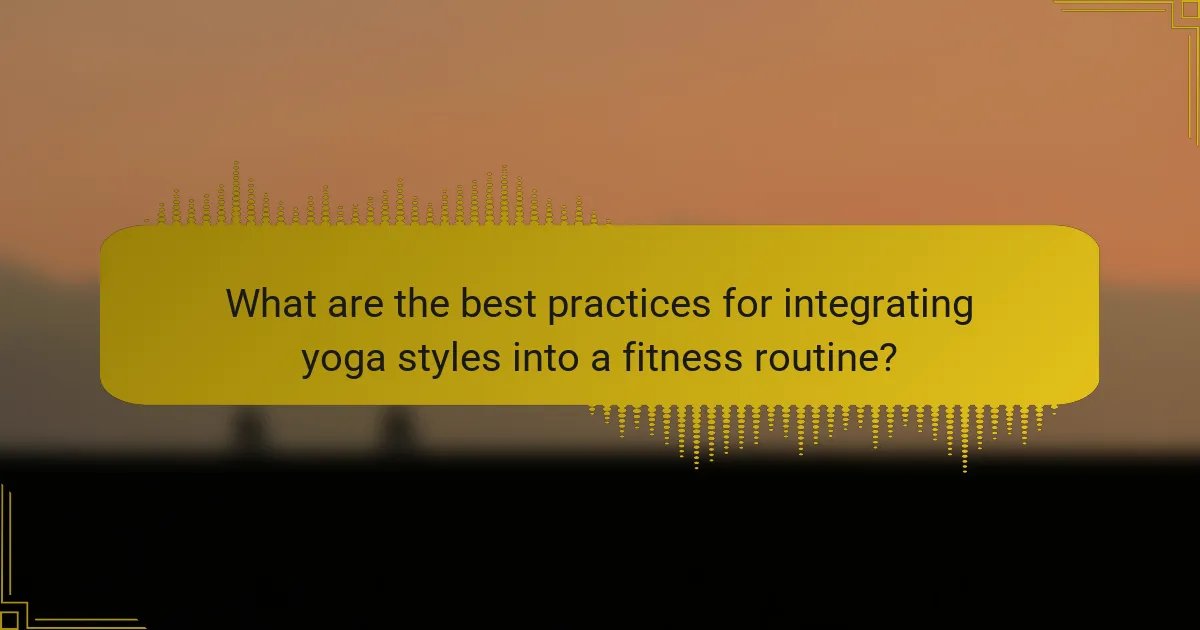
What are the best practices for integrating yoga styles into a fitness routine?
Incorporating various yoga styles into a fitness routine enhances flexibility, strength, and mindfulness. Focus on balancing different styles to maximize benefits.
1. Start with Hatha yoga for foundational strength and flexibility.
2. Integrate Vinyasa for dynamic movement and cardiovascular fitness.
3. Include Yin yoga for deep tissue stretching and relaxation.
4. Practice Kundalini to enhance mental clarity and spiritual growth.
5. Blend restorative sessions to promote recovery and mindfulness.
This approach ensures a comprehensive fitness routine that addresses physical and mental well-being.
How can individuals tailor their yoga practice to achieve personal flexibility goals?
Individuals can tailor their yoga practice to achieve personal flexibility goals by selecting specific styles and incorporating targeted techniques. Focus on styles like Hatha and Yin yoga, which emphasize deep stretching and hold poses longer, enhancing flexibility.
Incorporate dynamic movements from Vinyasa to improve range of motion. Consistent practice, ideally three to four times weekly, yields better results. Utilize props like blocks and straps to support deeper stretches safely.
Set measurable goals, such as achieving specific poses, to track progress. Mindfulness techniques, including breath awareness, can enhance the overall experience and deepen the connection to body sensations during practice.
What common mistakes should be avoided when practicing yoga for strength building?
To build strength effectively through yoga, avoid common mistakes such as neglecting proper alignment, skipping warm-ups, and overexerting yourself. Prioritize listening to your body and focusing on controlled movements. Additionally, don’t rush through poses; instead, hold them to build muscle engagement. Consistency is key, so practice regularly while integrating mindfulness to enhance both strength and mental focus.
What expert insights can help optimize the combination of yoga styles for mindfulness?
Combining different yoga styles can enhance mindfulness through diverse practices. Integrating Hatha for physical alignment, Vinyasa for flow, and Yin for deep relaxation cultivates awareness. Each style contributes uniquely: Hatha builds strength, Vinyasa enhances breath control, and Yin promotes introspection. This combination fosters a holistic approach to mindfulness, allowing practitioners to connect body and mind effectively.